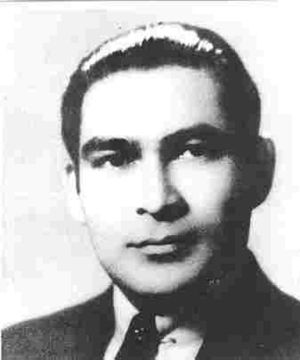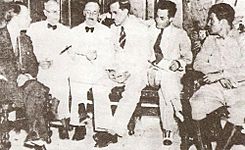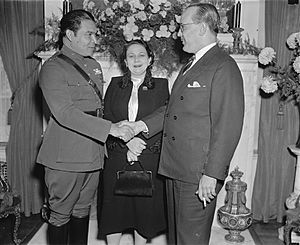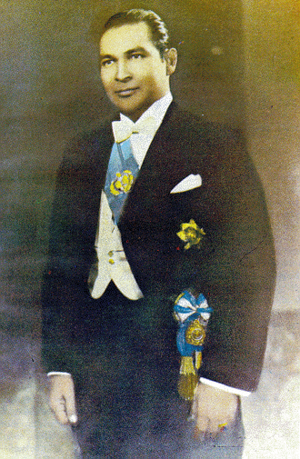Fulgencio Batista facts for kids
Quick facts for kids
Fulgencio Batista
|
|
|---|---|
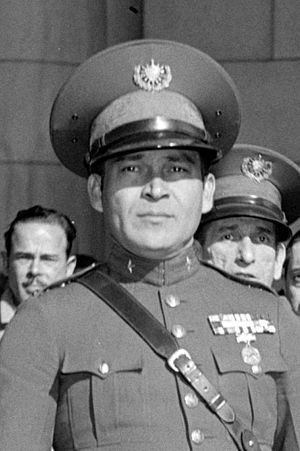
Batista in 1938
|
|
| President of Cuba | |
| In office March 10, 1952 – January 1, 1959 |
|
| Prime Minister |
|
| Vice President | Rafael Guas Inclán |
| Preceded by | Carlos Prío Socarrás |
| Succeeded by | Anselmo Alliegro |
| In office October 10, 1940 – October 10, 1944 |
|
| Prime Minister |
|
| Vice President | Gustavo Cuervo Rubio |
| Preceded by | Federico Laredo Brú |
| Succeeded by | Ramón Grau |
| Cuban Senator | |
| In office June 2, 1948 – March 10, 1952 |
|
| Constituency | Las Villas |
| Personal details | |
| Born |
Rubén Zaldívar
January 16, 1901 Banes, Cuba |
| Died | August 6, 1973 (aged 72) Marbella, Málaga, Spain |
| Resting place | Saint Isidore Cemetery |
| Political party |
|
| Spouses |
Elisa Godínez Gómez
(m. 1926; div. 1946)Marta Fernandez Miranda
(m. 1946) |
| Children | 9 |
| Other names | Fulgencio Batista y Zaldívar (full name from 1939) |
| Military service | |
| Allegiance | |
| Branch/service | Cuban Army |
| Years of service | 1921–1940 |
| Rank | Colonel |
Fulgencio Batista y Zaldívar (born Rubén Zaldívar; January 16, 1901 – August 6, 1973) was a Cuban military officer and politician. He served as Cuba's elected president from 1940 to 1944. Later, with support from the United States, he became a military leader from 1952 to 1959. He was overthrown by the Cuban Revolution.
Batista first gained power during the Sergeants' Revolt in 1933. This revolt removed the government of Carlos Manuel de Céspedes y Quesada. Batista then made himself chief of the armed forces. He held the rank of colonel. He controlled the "pentarchy," a group of five leaders who acted as Cuba's head of state. He kept control through several presidents who followed his orders until 1940. In 1940, he was elected president based on popular promises. He then put in place the 1940 Constitution of Cuba and served until 1944. After his term, Batista moved to Florida. He returned to Cuba to run for president in 1952. Facing likely defeat in the election, he led a military takeover. This coup stopped the election and removed President Carlos Prío Socarrás.
Once back in power, Batista received money, military help, and supplies from the United States government. He stopped the 1940 Constitution and took away many political freedoms. This included the right to strike. He joined forces with the richest landowners who owned large sugar farms. He led an economy that was not growing, which made the gap between rich and poor Cubans wider. Most of the sugar industry became owned by the U.S. and foreigners owned 70% of Cuba's farmland. Batista's government then began to profit from Cuba's businesses. He made deals with American crime groups and large U.S. companies. These companies received profitable contracts. To stop growing unhappiness among the people, Batista controlled the media more strictly. He also used his secret police to stop protests. Many people were killed during this time, especially as ideas about socialism became more popular.
These actions did not stop the unrest. Instead, they caused more widespread resistance. For two years (December 1956 – December 1958), Fidel Castro's 26th of July Movement and other rebel groups led a guerrilla uprising. This uprising was against Batista's government. It ended with his defeat by rebels led by Che Guevara at the Battle of Santa Clara on New Year's Day 1959. Batista immediately left Cuba with a large personal fortune. He went to the Dominican Republic, where his military ally Rafael Trujillo was in power. Batista later found a safe place to live in Oliveira Salazar's Portugal. He lived first on the island of Madeira and then in Estoril. He was involved in business in Spain. He died there from a heart attack on August 6, 1973.
Contents
Early Life and Rise to Power
Fulgencio Batista was born in Veguita, a town in Banes, Cuba, in 1901. His parents, Belisario Batista Palermo and Carmela Zaldívar González, had fought in the Cuban War of Independence. Batista had Spanish, African, Chinese, and possibly some Taíno heritage. His mother named him Rubén and gave him her last name, Zaldívar. His father did not want to register him as a Batista. Legally, he was Rubén Zaldívar until 1939. At that time, as Fulgencio Batista, he became a candidate for president. It was found that this name was not on his birth records. He had to delay his candidacy and pay a large fee.
Both of Batista's parents are thought to have been of mixed race. One may have had Indigenous Caribbean roots. Batista first went to a public school in Banes. Later, he took night classes at an American Quaker school. He left home at age 14 after his mother died. He came from a poor background. He worked as a laborer in sugar cane fields, on docks, and on railroads. He was also a tailor, mechanic, charcoal seller, and fruit seller. In 1921, he went to Havana. In April, he joined the army as a private. After learning shorthand and typing, Batista left the army in 1923. He worked briefly as a stenography teacher. Then he joined the Guardia Rural (rural police). He later returned to the army as a corporal. He became a secretary to a colonel. In September 1933, he was a sergeant stenographer. He acted as the secretary for a group of non-commissioned officers. They planned a "sergeants' conspiracy" to get better conditions and chances for promotion.
The 1933 Coup and Batista's Influence
In 1933, Batista led an uprising called the Sergeants' Revolt. This was part of a coup that overthrew the government of Gerardo Machado. Machado was replaced by Carlos Manuel de Céspedes y Quesada. Céspedes did not have enough political support to stay in power and was soon replaced.
A short-lived group of five presidents, known as the Pentarchy of 1933, was then formed. This group included a representative from each group that opposed Machado. Batista was not a member of this group. However, he controlled Cuba's armed forces. Within days, Ramón Grau San Martín, who represented students and professors, became president. Batista became the Army Chief of Staff, with the rank of colonel. This effectively put him in control of the presidency. Most of the higher-ranking officers were forced to retire.
Grau was president for just over 100 days. Batista, working with the U.S. envoy Sumner Welles, forced him to resign in January 1934. Grau was replaced by Carlos Mendieta. Within five days, the U.S. recognized Cuba's new government. This government lasted eleven months. Batista then became the powerful figure behind a series of presidents who followed his lead. This continued until he was elected president in 1940. After Mendieta, governments were led by José Agripino Barnet and Miguel Mariano Gómez. Then Federico Laredo Brú ruled from December 1936 to October 1940.
First Time as President (1940–1944)
Batista was supported by the Democratic Socialist Coalition. This group included the Communist Party. In the first presidential election under the new Cuban constitution in 1940, Batista defeated Grau. He served a four-year term as President of Cuba. He was the first, and so far only, non-white Cuban in that office. Batista was supported by the original Communist Party of Cuba. This party was not very strong at the time. Their support was mainly because of Batista's labor laws and his support for labor unions. The Communists had close ties with unions. During this time, Batista made important social changes. He also put in place many economic rules and policies that helped unions.
Cuba joined World War II on the side of the Allies on December 9, 1941. It declared war on Japan two days after the attack on Pearl Harbor. On December 11, Batista's government declared war on Germany and Italy. In December 1942, after visiting Washington, Batista said Latin America would support a war with Francisco Franco's Spain. He called that government "fascist."
Life After His First Presidency
In 1944, Batista's chosen successor, Carlos Saladrigas Zayas, was defeated by Grau. In the last months of his presidency, Batista tried to make it harder for the new Grau government.
Soon after, Batista left Cuba for the United States. He said, "I just felt safer there." He divorced his first wife, Elisa, and married Marta Fernández Batista in 1945. Two of their four children were born in the United States.
For the next eight years, Batista stayed out of the spotlight. He spent time in New York City and Daytona Beach, Florida.
He still took part in Cuban politics. He was elected to the Cuban Senate in 1948 while he was away. When he returned to Cuba, he decided to run for president. He formed the United Action Party. When he took power, he founded the Progressive Action Party. However, he never got back his earlier popular support. Still, the unions supported him until the end.
Return to Power (1952–1959)
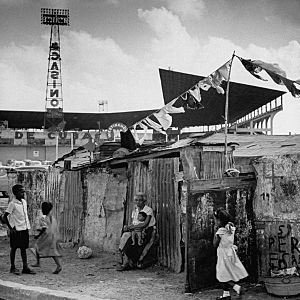
In 1952, Batista ran for president again. In a race with three main candidates, Roberto Agramonte was leading in all polls. He was followed by Carlos Hevia. Batista's group was a distant third.
On March 10, 1952, three months before the elections, Batista led a military coup and took power. He removed the current President Carlos Prío Socarrás, canceled the elections, and took control as a temporary president. The United States recognized his government on March 27.
Cuba's Economy Under Batista
When Batista took power, Cuba was quite successful compared to other Latin American countries. According to Batista's government, Cuba was one of the five most developed countries in the region. This was true even though a third of Cubans still lived in poverty. In the 1950s, Cuba's gross domestic product (GDP) per person was similar to Italy's at that time. However, it was still only a sixth of the United States' GDP. Even though there was a lot of corruption and inequality under Batista, the wages for Cuban factory workers went up a lot. In 1953, the average Cuban family earned about $6.00 a week. Also, 15% to 20% of workers were often unemployed. Only a third of homes had running water. Despite this, the average factory worker's salary in Cuba was the world's eighth-highest in 1958. The average farm worker's wage was higher than in some European countries.
U.S. Support and Influence
The U.S. government used its influence to help American companies in Cuba. This made many Cubans angry. By the late 1950s, U.S. businesses owned 90% of Cuban mines. They also owned 80% of public services, 50% of railways, 40% of sugar production, and 25% of bank deposits. This was about $1 billion in total. As a symbol of this relationship, ITT Corporation, an American phone company, gave Batista a Golden Telephone. This was to thank him for allowing a large increase in phone rates.
Earl E.T. Smith, a former U.S. Ambassador to Cuba, said in 1960 that the U.S. was so powerful in Cuba that the American ambassador was often more important than the Cuban president. Also, almost all aid from the U.S. to Batista's government was in the form of weapons. This only made Batista's rule stronger. It did not help the Cuban people's economic well-being.
Historian James S. Olson said the U.S. government became involved with Batista. This was because Batista strongly opposed communism. During the Cold War, this seemed to keep businesses stable and Cuba friendly to the U.S. So, Olson believed the U.S. government had no problem dealing with him, even if he was a harsh ruler.
Batista, Fidel Castro, and the Cuban Revolution
On July 26, 1953, a little over a year after Batista's second coup, a small group of revolutionaries attacked the Moncada Barracks in Santiago. Government forces easily defeated the attack. They jailed its leaders, and many others fled. The main leader of the attack was Fidel Castro. He was a young lawyer who had planned to run for parliament in the canceled 1952 elections. Castro felt that Batista's coup had ruined his political career. After the Moncada attack, Batista stopped constitutional protections. He used police tactics more and more to try to scare the people.
Batista held an election in 1954. He ran as the candidate for a group of parties. The opposition was divided. Some wanted to boycott the elections, while others wanted to participate if certain rights were guaranteed. The CIA had predicted that Batista would do anything to win. Batista used unfair methods to make sure he won. This led most other parties to boycott the elections. Former President Ramón Grau San Martín withdrew from the campaign days before the election. He said his supporters had been threatened. So, Batista was elected president with the support of 45.6% of registered voters.
By late 1955, student protests and anti-Batista demonstrations were common. Unemployment became a problem as new graduates could not find jobs. Batista responded with more control. All young people were seen as possible revolutionaries. The University of Havana was closed on November 30, 1956, because of its opposition to Batista. It did not reopen until 1959. On March 13, 1957, student leader José Antonio Echeverría was killed by police. This happened after he announced that Batista had been killed in a student attack on the Presidential Palace. Batista survived, and many students involved in the attack were killed.
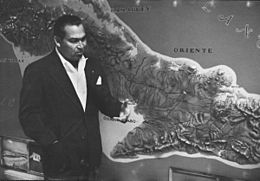
In April 1956, Batista called military leader Col. Ramón Barquín back to Cuba. Batista thought Barquín would support him and promoted him to General. However, Barquín was already planning a coup. On April 6, 1956, Barquín led hundreds of officers in a coup attempt. But the plan was betrayed. Barquín was sentenced to eight years in prison.
The removal of many officers weakened the Cuban army. This made it harder for them to fight Castro and his rebels. Batista's police responded to growing unrest by killing young men in the cities. However, his army was not effective against the rebels in the Sierra Maestra and Escambray Mountains. Some of Batista's generals later criticized him. They said Batista's constant involvement in their military plans hurt army morale.
To get information about Castro's army, Batista's secret police questioned people. Many innocent people were treated harshly by Batista's police. Suspects, including young people, were publicly killed to warn others. This harsh behavior backfired and increased support for the rebels. In 1958, 45 organizations signed a letter supporting the July 26 Movement. These included groups of lawyers, architects, dentists, and accountants. Castro, who had first relied on the poor, was now gaining support from the middle classes.
The United States gave Batista planes, ships, tanks, and new technology. However, in March 1958, the U.S. announced it would stop selling weapons to the Cuban government. Soon after, the U.S. placed an arms embargo. This further weakened Batista's government.
Elections were set for June 1958 but were delayed until November 1958. Castro and the revolutionaries called for a general strike. They also placed several bombs in civilian areas. Three main candidates ran in the elections. On Election Day, estimates for voter turnout were between 30% and 50% in areas where voting happened. This did not include parts of Las Villas and Oriente, which Castro controlled. Batista declared Andrés Rivero Agüero the winner.
The U.S. did not accept the election results. The American ambassador to Cuba, Earl Smith, told Agüero that the U.S. would not support his government. Smith also told Batista that the U.S. believed he could not keep control and should retire.
The Cuban Revolution and His Fall
On December 31, 1958, at a New Year's Eve party, Batista told his cabinet and top officials that he was leaving the country. After seven years, Batista knew his presidency was over. He fled Cuba early on January 1, 1959. At 3:00 a.m., Batista boarded a plane with 40 supporters and family members. He flew to the Dominican Republic. A second plane left Havana later that night, carrying ministers and officers. Batista took a personal fortune of over $300 million that he had gained through corruption. Critics said Batista and his supporters took as much as $700 million in art and cash when they left.
As news of Batista's government falling spread through Havana, The New York Times described joyful crowds in the streets. Car horns were honking. The black and red flag of the July 26 Movement waved on cars and buildings. The atmosphere was chaotic. On January 8, 1959, Castro and his army entered Havana victoriously. Batista was not allowed into the United States. Mexico also refused him. Portugal's leader António Salazar allowed him to live there. The condition was that he stay completely out of politics.
Historians believe that between hundreds and 20,000 Cubans were killed under Batista's rule.
Personal Life
Marriages and Children
Batista married Elisa Godínez y Gómez (1900–1993) on July 10, 1926. They had three children: Mirta Caridad (1927–2010), Elisa Aleida (born 1933), and Fulgencio Rubén Batista Godínez (1933–2007). She was very dedicated to him and their children. Their daughter remembered them as a "happy, young couple" until their sudden divorce. To her surprise, he divorced her in October 1945 against her will. He did this to marry his longtime partner Marta Fernandez Miranda.
He married Marta Fernández Miranda (1923–2006) on November 28, 1945. This was shortly after his divorce was final. They had five children: Jorge Luis (born 1942), Roberto Francisco (born 1947), Carlos Manuel (1950–1969), Fulgencio José (born 1953), and Marta María Batista Fernández (born 1957).
Death
After he fled to Portugal, Batista lived in Madeira. Later, he lived in Estoril. He died of a heart attack on August 6, 1973, in Marbella, Spain. This was two days before a team of assassins from Castro's Cuba was reportedly planning to kill him.
Marta Fernández Miranda de Batista, Batista's widow, died on October 2, 2006. Her son, Roberto Batista, said she died at her home in West Palm Beach, Florida. She had suffered from Alzheimer's disease. She was buried with her husband and son in the Cementerio Sacramental de San Isidro in Madrid.
Books Written by Batista
- Estoy con el Pueblo (I am With the People), Havana, 1939
- Respuesta, Manuel León Sánchez S.C.L., Mexico City, 1960
- Piedras y leyes (Stones and Laws), Mexico City, 1961
- Cuba Betrayed, Vantage Press, New York, 1961
- To Rule is to Foresee, 1962
- The Growth and Decline of the Cuban Republic, Devin-Adair Company, New York, 1964
See also
 In Spanish: Fulgencio Batista para niños
In Spanish: Fulgencio Batista para niños


